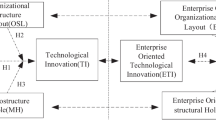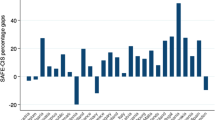Conclusion
Our analysis lends support to both sides of the debate concerning the optimal firm size for achieving technical advance. It provides a basis for why industries composed of many small firms will tend to exhibit greater diversity in the approaches to innovation pursued, and why greater diversity will contribute to more rapid technological change. It also provides a basis for why industries populated by larger firms will achieve a more rapid rate of technical advance on the approaches to innovation that are pursued. These arguments together suggest that a tradeoff exists between the appropriability advantage of large size and the advantages of diversity that accrue from numerous small firms. Footnote 1
Our analysis has been more appreciative than rigorous and, indeed, often explicity speculative. While we attempted to raise important questions, our framework requires more structuring before we can be confident about any of our conclusions. Even in its inchoate form, however, our analysis demonstrates that much needs to be done before the current debate about firm size can seriously inform policy. If we accept the plausibility of our basic framework, it focuses attention on a range of issues and questions. The fundamental premise of our analysis is that firm capabilities and perceptions differ within industries. This premise is not, however, widely reflected in analyses of industry behavior and performance, which typically take some representative firm as their starting point. Indeed, the analytic utility of our particular premise deserves scrutiny. Are differences in firm capabilities and perceptions as critical to explaining the industry patterns in innovative activity and performance as we suggest? Do these differences persist? Is our abstract characterization of these differences and their effects on innovative activity up to the task of providing a basis for policy?
These intraindustry differences in capabilities and perceptions underpin the hypothesized relationship in our framework between the number of firms within an industry and the number of distinct technological activities pursued by the industry as a whole. Surely this hypothesis should be tested. To establish the relationship between numbers of firms and technological diversity, we also made two important assumptions, which themselves should be examined. First, we assumed that firms independently decide upon which approaches to innovation to pursue.This assumption precludes the clustering of firms around innovative activities due to imitation, a phenomenon highlighted by Nelson (1981) and Scott (1991). To the degree that innovative activities yield relatively fast, public results, the assumption may be suspect. While our evidence indirectly suggests that such clustering may not be critical for explaining innovative activity in a wide range of industries, more research would be helpful. Second, we assumed that the number of approaches to innovation pursued by firms is independent of their size, implying large and small firms will tend to pursue the same number of approaches. This assumption probably does not apply to the smallest firms within an industry, particularly to the extent that such firms are often not full line manufacturing firms. Does it apply, however, to the medium to large firms that account for the preponderance of R&D and economic activity inthe manufacturing sector? While our evidence again provides indirect support for this claim, more empirical and theoretical research is indicated.
We also made other claims and assumptions that deserve further attention. For example, we argued that greater technological diversity stimulates technical advance and provides gross increments to social welfare. Assuming it exists, the mechanism linking diversity and technical advance has never been examined empirically and is not obvious. Our assumption that expected firm growth due to innovation is increamental played an important role in permitting usto hypothesize an appropriability advantage of large size. Again, both the assumption and its alleged effect on innovative activity are worth examining. Finally, we also need to test whether the relationship between R&D and firm size within industries depends upon appropriability conditions, particularly upon the extent to which firms can sell their innovations or grow rapidly due to innovation.Footnote 2 In conclusion, this litany of reasonable but unsubstantiated assumptions and arguments should make clear that this paper is only a modest beginning of a daunting research agenda.
Similar content being viewed by others
Notes
Others, suchas Nelson (1981), have also recognized a tradeoff between the diversity-inducing advantage of more competitive industry structures and advantages of large firm size, but not the particular tradeoff we have identified.
Cohen and Klepper (1990) demonstrate that if firms can sell some fraction of their innovations in disembodied form or if growth due to innovation is unconditioned by existing output levels, then large firm size will confer less of an advantage and R&D effort should rise less than proportionally with firm size.
References
Andrews, K. R., 1971, The Concept of Corporate Strategy, Homewood, Illinois: Dow Jones-Irwin.
Arrow, K., 1962, ‘Economic Welfare and the Allocation of Resources for Inventions’, in R. R. Nelson (ed.), The Rate and Direction of Inventive Activity, Princeton, NJ: Princeton University Press for the National Bureau of Economic Research.
Baldwin, W. L. and J. T. Scott, 1987, Market Structure and Technological Change, Chur: Harwood Academic Publishers.
Cohen, W. M. and S. Klepper, 1990, ‘A Reprise of Size and R&D’, mimeo, Carnegie Mellon University.
Cohen, W. M. and S. Klepper, 1991, ‘The Anatomy of Industry R&D Intensity Distributions’, American Economic Review, forthcoming.
Cohen, W. M. and D. Levinthal 1989, ‘Innovation and Learning: The Two Faces of R&D’, Economic Journal 99, 569–596.
Cohen, W. M. and D. Levinthal, 1990, ‘Absorptive Capacity: A New Perspective on Innovation and Learning’, Administrative Science Quarterly 35, 128–152.
Evenson, R. E. and Y. Kisley, 1976, ‘A Stochastic Model of Applied Research’, Journal of Political Economy 84, 265–281.
Ferguson, C. H., 1988, ‘From the People Who Brought You Voodoo Economics’, Harvard Business Review (May–June), 55–62.
Fisher, F. M. and P. Temin, 1973, ‘Returns to Scale in Research and Development: What Does the Schumpeterian Hypothesis Imply?, Journal of Political Economy 81, 56–70.
Gilder, G., 1988, ‘The Revitalization of Everything: The Law of the Microcosm’, Harvard Business Review (March–April) 49–61.
Jorde, T. M. and D. J. Teece, 1990, ‘Innovation and Cooperation: Implications for Competition and Antitrust’, The Journal of Economic Perspectives 4,75–96.
Kamien, M.I. and N. L. Schwartz, 1982, Market Structure and Innovation, Cambridge; Cambridge University Press.
Katz,M. L. and J. A. Ordover, 1990 ‘R&D Cooperation and Competion’, Brookings Paperson Economic Activity, Microeconomics, 137–203.
Klepper, S. and E. Graddy,1990, ‘The Evolution of New Industries and the Determinants of Market Structure’, The Rand Journal of Economics 21, 27–44.
Levin, R. C., A. Klevorick, R. Nelson and S. Winter, 1987, ‘Appropriating the Returns from Industrial Research and Development’, Brookings Papers on Economic Activity 3, 783–820.
Link, A. N. and L. L. Bauer, 1989, Cooperative Research in U.S. Manufacturing — Assessing Policy Initiatives and Corporate Strategies Lexington, Mass.: Lexington Books.
Marshall, A., 1961, Principles of Economics, New York: The Macmillan Company, 9th (variorum) edition, Vol. 1, with annotations by C. W. Guillebaud (based on New York: The Macmillan Company, 8th edition, 1920).
Nelson, R. R., 1981, ‘Assessing Private Enterprise: An Exegesis of Tangled Doctrine’, The Bell Journal of Economics 12, 93–111.
Nelson, R. R., 1982, ‘The Role of Knowledge in R&D Efficiency’, Quarterly Journal of Economics 97, 453–470.
Nelson, R. R., 1989, ‘What Is ‘Commercial’ and What Is ‘Public’ About Technology, and What Should Be?’, mimeo, presented at the Conference on Economic Growth and the Commercialization of New Technologies, Stanford University, September 11–12, 1989.
Nelson, R. R., 1990, ‘Capitalism as an Engine of Progress’, Research Policy 19, 193–214.
Nelson, R. R. and S. G. Winter, 1982, An Evolutionary Theory of Economic Change, Cambridge: Harvard University Press.
Nelson, R. R., M. J. Peck and E. D. Kalachek, 1967, Technology, Economic Growth, and Public Policy, Washington: Brookings Institution.
Norris, W. C., 1983, ‘How to Expand R&D Cooperation’, Business Week, April 11, p.21.
Noyce, R. N., 1990, ‘Cooperation Is the Best Way to Beat Japan’, New York Times, July 9, Section 3, p. 2.
Porter, M. E., 1980, Competitive Strategy: Techniques for Analyzing a Business, Industry and Competitors, New York: Free Press.
Rigdon, J. E., 1991, ‘Kodak Tries to Prepare for Filmless Era Without Inviting Demise of Core Business’, The Wall Street Journal, April 18, 1991, B1, B5.
Rogers, T. J., 1990, ‘Landmark Messages from the Microcosm’, Harvard Business Review (January–February), 24–30.
Sah, R. J., J. E. Stiglitz, 1986, ‘The Architecture of Economic Systems: Hierarchies and Polyarchies’, American Economic Review 76, 716–727.
Sah, R. J. and J. E. Stiglitz, 1988, ‘Committees, Hierarchies and Polyarchies’, Economic Journal 98, 451–470.
Scherer, F. M., 1970, Industrial Market Structure and Economic Performance, 1 st edition, Chicago: Rand McNally College Publishing Company.
Scherer, F. M., 1979, ‘The Welfare Economics of Product Variety: An Application to the Ready-to-Eat Cereals Industry’, Journal of Industrial Economics 28, 113–134.
Scherer, F. M., 1980, Industrial Market Structure and Economic Performance, 2nd edition, Chicago: Rand McNally College Publishing Company.
Scherer, F. M. and D. Ross, 1990, Industrial Market Structure and Economic Performance, 3rd edition, Boston: Houghton Mifflin.
Schumpeter, J. A., 1934, The Theory of Economic Development, Cambridge: Harvard University Press.
Schumpeter, J. A., 1942, Capitalism, Socialism, and Democracy, New York: Harper.
Scott, J. T., 1988, ‘Diversification Versus Cooperation in R&D Investment’, Managerial and Decision Economics 9, 173–186.
Scott, J., 1991, ‘Research Diversity and Technical Change’, in Z. Acs and D. Audretsch (eds.), Innovation and Technical Change, Ann Arbor: University of Michigan Press, pp. 132–151.
Shaffer, R. A., 1990, ‘Let a Thousand Companies Fight’, New York Times, July 9, Section 3, p. 2.
Spence, A. M., 1984, ‘Cost Reduction, Competition, and Industry Performance’, Econometrica 52, 101–121.
Von Weizsacker, C. C. 1980, Barriers to Entry, New York: Springer-Verlag.
Author information
Authors and Affiliations
Rights and permissions
About this article
Cite this article
Cohen, W.M., Klepper, S. The tradeoff between firm size and diversity in the pursuit of technological progress. Small Bus Econ 4, 1–14 (1992). https://doi.org/10.1007/BF00402211
Accepted:
Issue Date:
DOI: https://doi.org/10.1007/BF00402211




